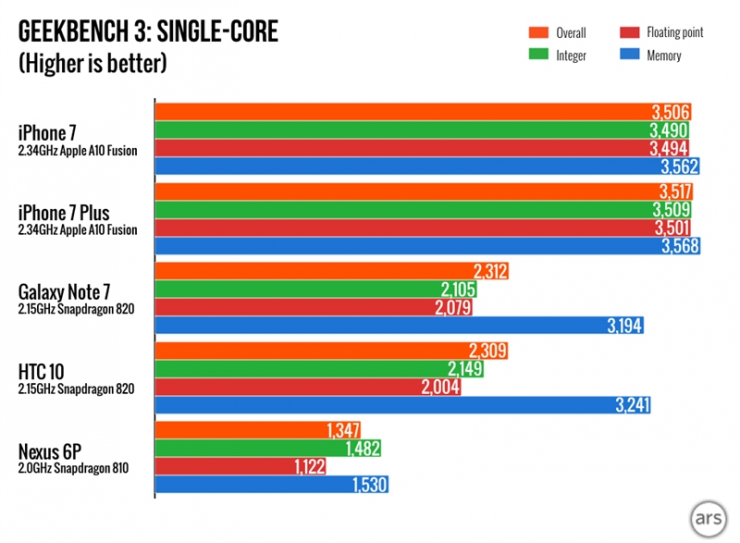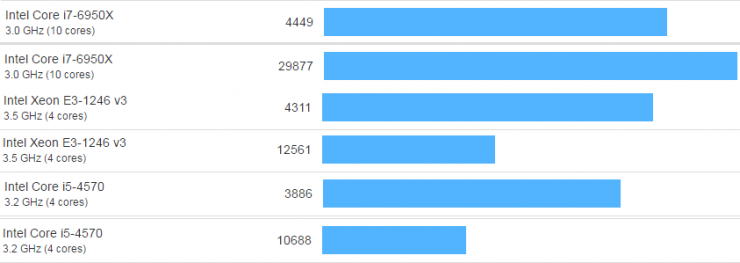
Since the release of the iPhone 7, evaluations of the latest A10 Fusion processors have been released. Recently, data from a number of domestic and international assessment agencies show that the performance of the A10 Fusion has reached the desktop-level CPU. In the future, Intel’s main competitor may no longer be AMD, but Apple.
So, how strong is the A10 Fusion processor in the end, and is it comparable to a desktop CPU? Lei Feng network (search "Lei Feng network" public concern) will be a detailed analysis of the A10 core number, running points and user experience in three aspects, decrypt the iPhone's most powerful processor in history.
What are the cores of A10 Fusion?Compared to previous generations of processors, the biggest change in A10 Fusion is dual-core conversion to quad-core, and this change usually means a significant increase in performance. From the running point of view, usually dual-core running points will be slightly less than twice the number of single-core, quad-core at least three times more than single-core, which is normal.
However, the A10 Fusion is not the case. We can see some clues from the data displayed by Apple's application software, Geekbench 4. According to Geekbench 4, the single-core run of the A10 Fusion is divided into 3291, while the multi-core run is only 5309, which is less than twice that of the single-core, which is obviously not the normal quad-core level.
(The following figure shows the screenshots under different search conditions. Therefore, the progress bar may not be proportional. Pay attention to running the sub-digits.)

This means that the A10 Fusion is obviously not a true quad-core processor, but a 2 large + 2 small size core. Two high-performance cores handle high loads, and two low-performance cores are used for daily task processing to reduce overall power consumption and improve endurance. And from the running point of view, Apple's 2+2 and the traditional ARM-size nuclear structure is not quite the same, because ARM can usually get the effect of four core firepower, while the A10 Fusion can only run two at the same time The core, that is, either 2 large cores or 2 small cores, is used to increase the operating efficiency and limit the power consumption level.
In addition, Apple adopts such a strategy to ensure application compatibility. Since previous A-series processors are dual-core, the continuation of dual-core on the A10 Fusion is well compatible with previous applications. Otherwise, the original old application will only use two cores in the A10 Fusion quad-core model. The embarrassing situation. Apple's strategy is undoubtedly the smartest and most cost-effective.
The above conclusion can also be verified from Apple's slogan. Apple's official website said:
“The A10 Fusion CPU has a new quad core design with two high-performance cores and two energy-efficient cores. The high-performance core runs up to 2 times faster than the iPhone 6, while the energy-efficient core is running. The power can be as low as one-fifth of the high-performance core."
In addition, in terms of battery life, Apple said that the iPhone 7 can provide two hours of usage time than the previous generation.
After finishing the basic structure of the A10 Fusion, we take a look at running points.
Performance by running pointsWhen it comes to CPU performance, in addition to actually using it for a while, the most intuitive manifestation may be running points. Regarding running software, in addition to the domestic security Bunny, there are two main industries that are relatively recognized: Geekbench and SPEC CPU 2006 (SPEC stands for Standard Performance Evaluation Corporation).
Geekbench is generally considered to be Apple's privilege running software, because its score calculation strategy and test items are optimized according to Apple's style and philosophy. The latest version of Geekbench 4 is currently released in August this year. SPEC CPU 2006 is more professional and objective. It does not have a single result, but it is comprehensively considered from the four dimensions of integer calculation, floating point calculation, calculation speed, and calculation capacity. The first version was released in August 2006 (hence the name 2006) and is currently updated to v1.2, released in September 2011.
From the results of Geekbench 4's single-core run, the A10 Fusion score was 3291. The running score was equivalent to 3266 points for the 2011 version of the iMac. The latter used the Intel Core i5-2500S processor with a maximum frequency of 2.7 GHz and quad-core. In addition, it also completely crushed the same level of Android phones, such as Huawei's p9 unicorn 955 processor, running only 1729; a plus 3 used Qualcomm Snapdragon 820, running only 1698; and the same use of Xiao Long 820 Note 7. Run points are 1488.
As you can see, the A10 Fusion is almost twice as much as the Android camp and is comparable to the Intel Core i5-2500S (Core i series 5 years ago 2nd generation) desktop processor 5 years ago.

In fact, the gap between the A10 Fusion and the Android camp is not that big.
Geekbench 4 modified some of the running algorithms on the basis of Geekbench 3, which caused the score of non-Apple CPUs to drop by nearly 30%, while the Apple's CPU did not change much. For example, the single-core run of Samsung Note 7 in Geekbench 3 is divided into 2312, while A10 Fusion is 3506. The same hardware environment, Apple did not lead Android twice, but the A10 Fusion than the Xiaolong 820 and other chip running score is a fact.

Look at the performance of the A10 Fusion and previous generation A9X under Geekbench 4 software. The single-core run A10 Fusion and A9X are 3291 and 3013, respectively, multi-core 5309 and 4867, the overall performance is only increased by about 10%, not much.

In the relatively more comprehensive SPEC CPU 2006 test results, we found that Apple's A9X and Intel's Core M series had a win and loss and basically stood at one level by comparing various test items. Therefore, the A10 Fusion with only 10% increase in backstepping performance can reach the following conclusions: The A10 Fusion ranks at the same level with Intel's emphasis on low-power, low-performance CPUs, such as the latest Intel Core M Series, or 5 Years ago the second generation product Core i5-2500S. And there is still a certain gap between the current professional desktop CPU.
So how big is this gap? We can see from the Geekbench 4 data a rough idea.
Geekbench 4 shows that the single-core and multi-core runs of the A10 Fusion are 3291 and 5309, respectively. In contrast, the current mainstream desktop CPU (4th and 6th generation products of Intel Core i series), such as the Intel Core i7-6950X, has a single core of 4449, multi-core up to 29877, Intel Core i5-4570, single core 3886, and multi-core. 10688; Intel Xeon E3-1246 v3, its single-core is 4311, multi-core reached 12561.
It can be seen that the A10 Fusion has little difference in single-core performance. However, in terms of multi-core performance, the A10 Fusion's performance and professional desktop CPUs are far from a grade. Most desktop CPUs have twice the core multi-core CPU performance and even more than double the A10 Fusion.

Talking about so many performances, in fact, what the user is most concerned about is whether or not the experience after the one actually started is really fast.
According to Apple’s official promotion and running points, the iPhone 7 equipped with the A10 Fusion has at least doubled its performance compared to the iPhone 6 or previous product, and at the same time it has been improved by one to two hours. However, compared to the previous generation iPhone 6s or iPad Pro with A9X, the performance increase is very limited. According to Cook, the iPhone 7 was originally intended to make users with iPhone 5\5S feel the urgency of upgrading.
On the other hand, in fact, regardless of whether the Android phone or the Apple phone, the performance of the CPU is not the performance of the CPU. The CPU of each flagship product is already in a state of overcapacity (excluding the optimization of individual systems and the imperfection of the App adapter). The current real impact on the user experience is actually the speed and battery life. Whether it is the iPhone 7 or the latest flagship Android phone, users have become less and less aware of the difference in system feedback and application startup speeds, which really make them feel unable to Accepted are either web surfing, online social networking, video watching, or network delays when playing online mobile games, or a stretch of battery life.
On the whole, regardless of whether it is running or CPU architecture design, Apple's latest A10 Fusion processor does have the status of king who can't be shaken on the mobile side, and has industry-leading performance and power control. However, to really go into the desktop market like the rumors mentioned (do not consider iPad Pro as a two-in-one product), there is still a certain distance. More importantly, whether the A10 Fusion has desktop-class performance is far less efficient than battery life and speed improvements. Therefore, for the average user, instead of caring about when the A10 Fusion can achieve the performance of the desktop-class CPU, it is better to look forward to the early popularization of 5G.
This article refers to Donews columnist maomaobear's article "How strong is Apple's A10 Fusion?"
Related Reading:
iPhone 7 processor performance exposure, single-core run sub-compaction Xiaolong 820
Some Apple-style innovations, domestic mobile phones can only look up
Home Speaker System,Loud Party Speakers,Wireless Speaker System,Portable Party Speakers
Newmax Electronics Co.,LTD , https://www.fspeaker.com